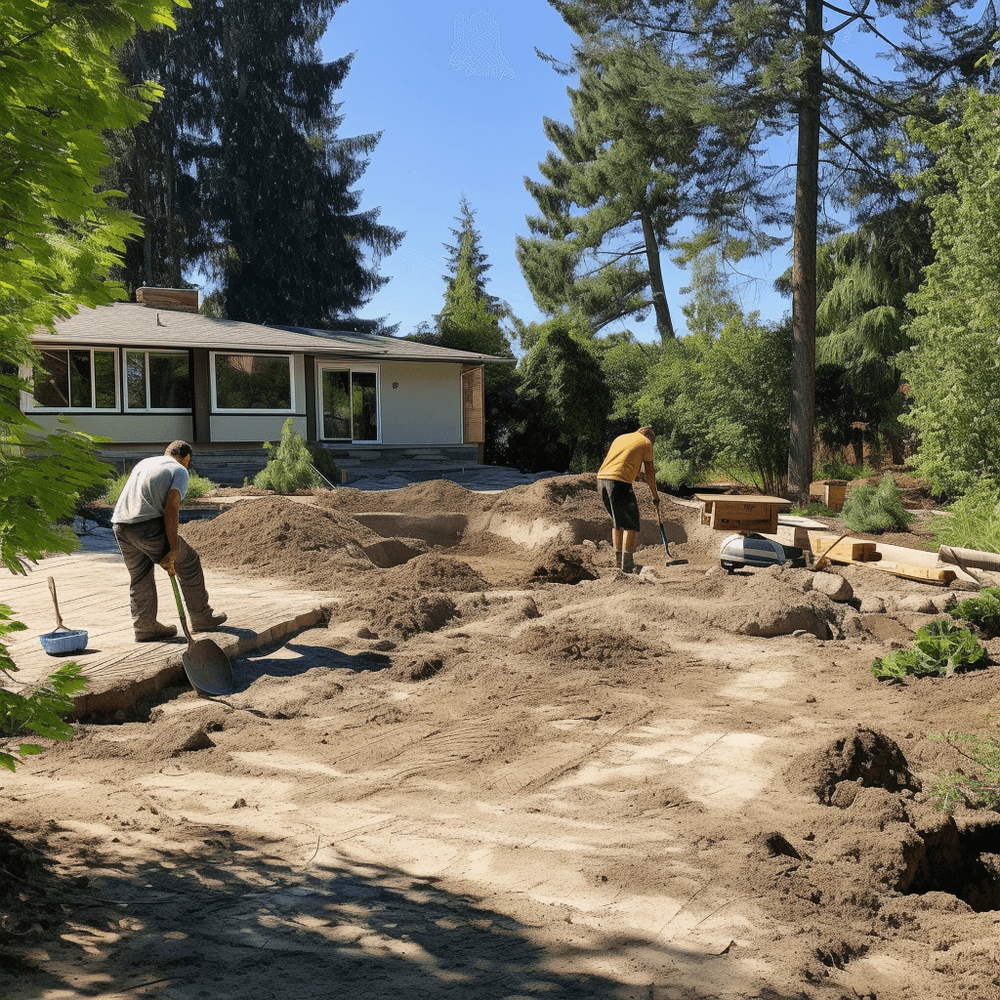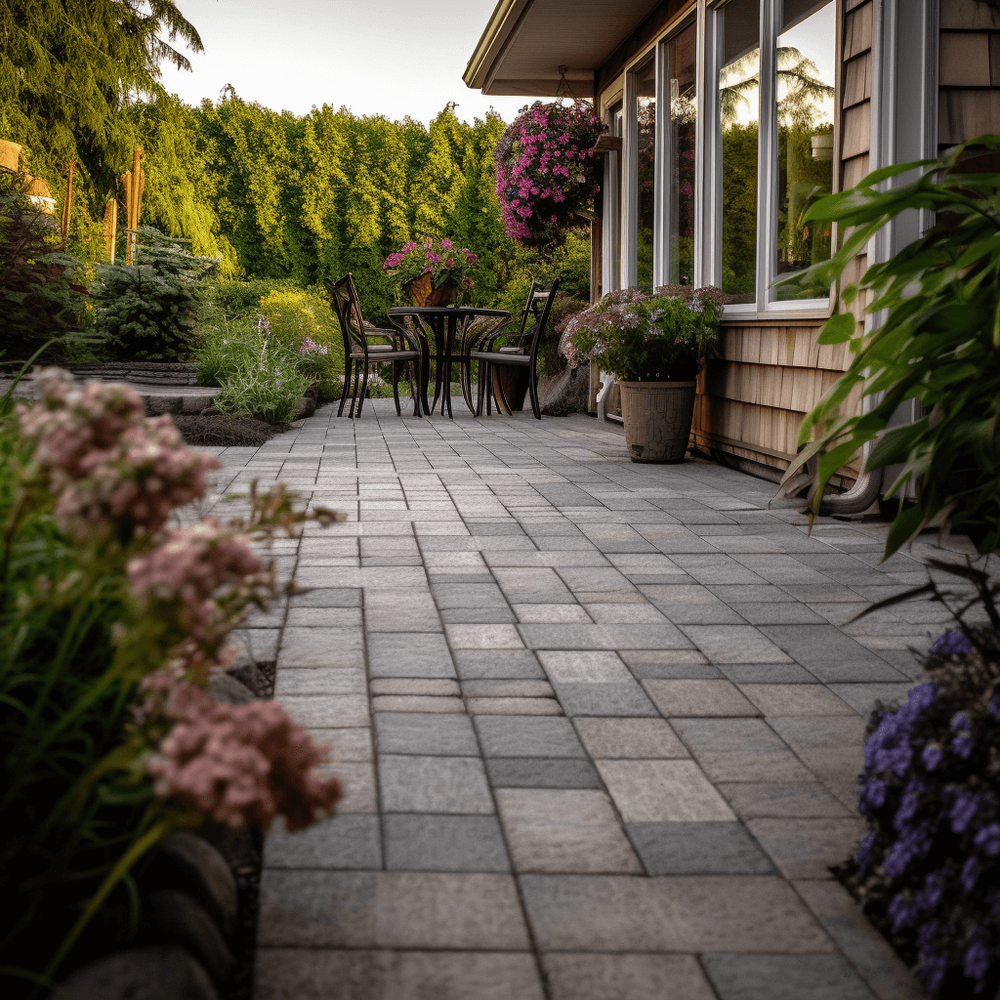
When it comes to laying pavers in your Arizona home, selecting the perfect base material is crucial. A solid and durable foundation can make all the difference between a long-lasting patio or walkway and one that crumbles under foot traffic.
n
In this blog post, we’ll explore various materials such as gravel, sand, crushed concrete, geo-textile fabric, bituminous material, mortar, and pedestals – examining their pros and cons to help you decide which one is most suitable for your needs.
Key Takeaways
- n
- A proper selection of base material is crucial in creating a durable and long-lasting paver installation.
- Different materials such as gravel, sand, crushed concrete, geo-textile fabric, bituminous material, mortar, and pedestals have their own pros and cons to consider before selecting the best one for your project.
- Factors like climate resistance, soil stability, weight-bearing capacity, budget availability, and environmental impact should be considered when choosing the right paver base material.
- It’s important to seek professional landscaping services if you need guidance on selecting the right materials or installing your pavers correctly.
n
n
n
n
Different Materials To Use As A Base For Pavers
Gravel or crushed stone, sand, crushed concrete, geo-textile fabric, bituminous material, mortar, and pedestals are some of the materials commonly used as a base for pavers.
Gravel Or Crushed Stone
Gravel or crushed stone is a popular choice for paver base material, particularly in the picturesque landscapes of Arizona. This versatile material provides a solid foundation for your pavers while also promoting proper drainage.
n
One notable example of using gravel or crushed stone as a paver base would be to create charming walkways and patios throughout your landscape. With numerous size options available – ranging from fine sand-like particles to larger stones – you can select the perfect texture to suit your design preferences.
n
As an added bonus, many local landscaping companies in Arizona are well-versed in this method and can assist with installation services once you’ve decided on the ideal material for your project.
Sand
Sand is another common material used as a base for pavers. It is relatively inexpensive and easy to work with, making it a popular choice for DIY projects. However, sand does have some drawbacks that should be considered before choosing it as your paver base material.
n
One of the biggest issues with using sand is its tendency to shift and settle over time, which can lead to an uneven surface and even cause your pavers to become unstable or sink into the ground.
n
Additionally, sand does not provide adequate drainage on its own, so if you live in an area prone to heavy rainfall or flooding, this may not be the best option for you.
Crushed Concrete
Crushed concrete is a popular base material for pavers because it provides good drainage and stability. It’s also eco-friendly since it’s made from recycled materials. However, crushed concrete can be more expensive than other base materials, and the quality can vary depending on the source.
n
Additionally, if not properly prepared or compacted, the crushed concrete can shift and settle over time, leading to uneven pavers.
Geo-textile Fabric
Another material that can be used as a base for pavers is geotextile fabric. This synthetic, permeable material is designed to allow water to drain through while preventing soil or other particles from mixing with the base layer of the patio.
n
While geotextile fabric may sound like a great option, it does come with its drawbacks. For one, it needs to be installed correctly in order to be effective; if not properly secured, the fabric may shift and cause problems down the line.
n
Additionally, because it doesn’t provide any weight-bearing capacity on its own, an additional layer of crushed stone or sand must be added before laying down the actual pavers.
Bituminous Material
Bituminous material, also known as asphalt, is a common option for a paver base. It is often used on commercial properties due to its high load-bearing capacity and durability.
n
However, it can be costly and difficult to install properly without professional help. The main benefit of using bituminous material as a paver base in Arizona’s hot climate is that it helps prevent erosion and keeps the pavers in place during monsoon season.
n
But it may not be an ideal option for homeowners with pets or high foot traffic since it tends to stick to shoes or pet feet and track into the house.
Mortar
Mortar is another material that can be used as a base for pavers. It consists of cement, sand, and water mixed together to create a paste-like substance. The mixture is spread over the compacted soil, serving as both a bonding agent for the pavers and a leveling layer.
n
One drawback of using mortar as a paver base material is that it creates a solid surface that restricts water drainage. This can lead to puddling on top of the pavement and cause damage over time.
n
Additionally, repairs are challenging since individual stones cannot be easily replaced without breaking them apart from the surrounding mortar bed.
Pedestals
Pedestals are a newer innovation in paver base materials that have gained popularity in recent years. These small, adjustable units are placed directly on the ground and can be used to create a stable surface for pavers without the need for a traditional crushed stone or sand base.
n
Pedestals work particularly well in areas with poor drainage or unstable soil, as they allow water to flow freely underneath the pavers and prevent shifting or settling over time.
n
However, it’s worth noting that pedestals aren’t suitable for every situation. They’re typically best used when installing large-format pavers or irregularly shaped stones that would otherwise be difficult to lay evenly on a flat surface.
n
They may also not provide enough support for heavily trafficked areas like driveways or commercial walkways.

Pros And Cons Of Each Paver Base Material
Different paver base materials have unique advantages and disadvantages to consider, such as gravel’s excellent drainage capabilities but the tendency to shift over time, sand’s affordability and flexibility but lack of stability for heavy traffic areas, and concrete’s durability but difficulty in installation and higher cost.
Climate And Drainage
In Arizona, where the climate can be hot and dry, it’s important to consider how your paver base material will handle both excess moisture and extreme temperature changes.
n
A well-draining base will help prevent water damage during monsoon season while also ensuring that your pavers don’t shift or crack due to expansive soils. Using a material like a geotextile fabric can help stabilize soil beneath the pavers, reducing the risk of shifting or settling over time.
n
Additionally, materials like bituminous asphaltic concrete can withstand high temperatures without melting or cracking, making them ideal for areas with intense sun exposure.
Soil Type And Stability
One essential factor to consider when choosing the best material as a base for pavers is the soil type and stability of your landscape. If you have soft or clay soil, it can lead to settling in high-traffic areas, causing the pavers to shift and become uneven over time.
n
In contrast, if you have rocky or sandy soil with adequate drainage, it can provide greater stability for your paver installation.
n
To ensure proper soil stabilization, professionals typically use a compacted layer of crushed stone or gravel as a foundation for their paver installation. This not only stabilizes the soil but also provides ample space for water drainage away from the surface area.
Weight-Bearing Capacity
It is important to consider the weight-bearing capacity of a paver base material when choosing the best option for your patio or walkway. A stable and durable base ensures that the paving stones will not sink or shift over time, even with regular foot traffic or heavy loads.
n
Crushed stone and gravel are popular options due to their high weight-bearing capacity, making them ideal choices for driveways or commercial areas where large vehicles may be parked.
n
For residential use, washed concrete sand is recommended by the Interlocking Concrete Pavement Institute (ICPI) as it can adequately support both light-traffic patios and moderately-used walkways.
Budget And Availability
Budget and availability play a crucial role when choosing the best material for a paver base. While sand, gravel, and crushed stone are readily available in most areas, some materials like geotextile fabric or bituminous material may be harder to find.
n
Additionally, prices can vary depending on factors such as location and demand.
n
It’s essential to consider your budget and the availability of materials before starting any landscaping project involving pavers. Doing so will help you avoid unnecessary expenses and delays caused by unavailable or expensive base materials.
Environmental Impact
When it comes to choosing a material for your paver base, it’s important to also consider the environmental impact. Using recycled materials, such as crushed concrete or reclaimed asphalt pavement, can be a more sustainable option and reduce waste in landfills.
n
Additionally, using permeable pavers or incorporating drainage systems into your design can help prevent stormwater runoff and promote groundwater recharge.
n
It’s worth noting that some materials may have a higher carbon footprint due to transportation costs if they aren’t locally sourced. However, this can be offset by choosing durable materials that will last longer and require less maintenance over time.

Best Material To Use As A Base For Pavers
According to Interlocking Concrete Pavement Institute (ICPI), washed concrete sand is the best material to use as a base for pavers due to its ability to provide excellent drainage and stability, making it suitable for different weather conditions.
Interlocking Concrete Pavement Institute Recommendation Of Washed Concrete Sand
According to the Interlocking Concrete Pavement Institute (ICPI), washed concrete sand is their recommended material for a paver base. This type of sand has been screened and washed to remove impurities, ensuring it is clean and free from debris that could affect drainage.
n
Washed concrete sand provides a stable base for patio pavers because it compacts well without becoming too hard or brittle over time. It allows water to drain through easily while also remaining firm enough to support the weight of foot traffic and outdoor furniture.
n
When choosing the best material for your paver base, consider factors such as climate, soil stability, weight-bearing capacity, budget, and availability.
Factors To Consider When Choosing The Best Material
When choosing the best material for a paver base, there are several factors to consider that can affect the overall outcome of your landscaping project. One crucial factor is climate and drainage.
n
Certain materials may be better suited for areas with heavy rainfall or extreme temperatures.
n
Another consideration is weight-bearing capacity, especially if you plan on using your patio or walkway for heavy traffic. Budget and availability are also essential factors since some materials may be more expensive or harder to find than others.
n
For example, crushed stone made from recycled concrete can be an environmentally friendly choice that provides excellent drainage and stability at an affordable price point.

How To Install A Paver Patio Base
To ensure a successful paver patio installation, it’s important to follow these seven steps for installing the base: (1) excavate the area, (2) add and compact 4-6 inches of aggregate sub-base material, (3) add and screed 1 inch of bedding sand, (4) install edge restraints, (5) layout pavers in desired pattern and cut as necessary, (6) sweep joint sand into gaps between pavers and compact surface again, (7) repeat sweeping and compacting until joints are full.
Steps To Installing A Paver Patio Base
Installing a paver patio base is an essential part of the process. The first step is to measure and mark the area where you want to install your patio. Next, remove any ,grass or debris from the site before excavating 8-10 inches of soil below grade level.
n
Once that’s done, it’s time for the actual installation process. First, spread and compact your chosen paver base material evenly across your excavation site in 2-3 inch layers until you achieve a depth of four inches for gravel or six inches for crushed stone bases and
n
Finally, you can lay down bedding sand over the compacted paver base material and screed it off using two-inch-diameter metal pipes set into the ground as guides and ,anchors to your gazebo. This will create an even surface for laying down your paving stones in whatever design you prefer ultimately.
Tools And Equipment Needed
To install a paver patio base, you’ll need the right tools and equipment to ensure success. Some must-haves include gloves, a shovel, a wheelbarrow or bucket for transporting materials, measuring tape or string to mark out your area, and a level to ensure an even surface.
n
A plate compactor is also essential to compact the paver base material properly. For larger projects, renting heavy-duty equipment such as a skid steer loader or mini excavator may be necessary.
n
When it comes to choosing the best material for your paver base in Arizona’s unique climate and soil type conditions, it helps to work with local landscaping professionals who can offer tailored guidance based on their expertise and knowledge.
Tips For Successful Installation
To ensure a successful ,installation of a paver patio base, it is essential to follow some basic tips. Proper excavation and soil preparation are vital in providing a stable foundation for the pavers.
n
Before installing the base material, ensure that all vegetation and roots are removed from the area to prevent future cracks or shifting. It’s crucial to use compacting equipment such as a plate compactor or jumping jack tamper during each layer of base material installation.
n
Adequate drainage should be considered when choosing your base material, especially in areas with heavy rainfalls like Arizona.
n
Furthermore, avoid walking on freshly laid materials to prevent shifting before the final sand set and paving commences. Joint sand acts as a buffer between the individual stones; therefore, proper filling– preferably twice- ensures long-lasting durability once completed.
Conclusion
In conclusion, choosing the best material for a paver base requires careful consideration of factors like climate, soil type, weight-bearing capacity, and budget. While professionals recommend washed concrete sand as the top choice for interlocking concrete pavement installations, other materials such as crushed stone or gravel can be effective in certain situations.
n
Proper installation is also critical to ensure a stable foundation for your patio or pathway. Remember to seek out professional landscaping services if you need help with your paver installation project.
nn

